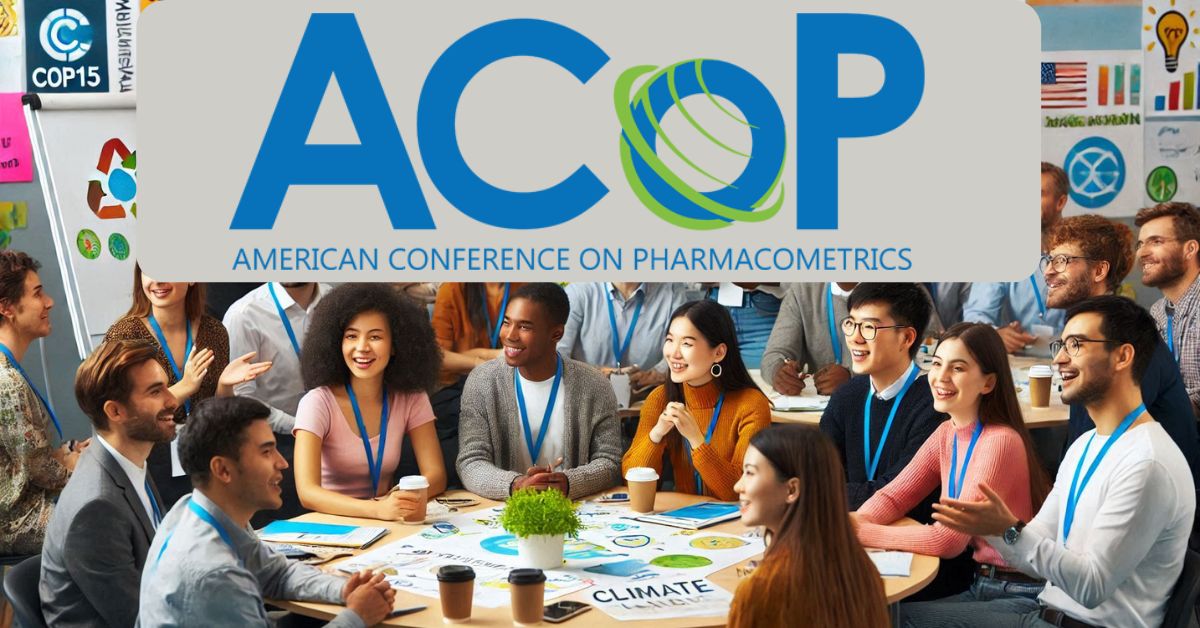The 15th Annual American Conference on Pharmacometrics, ACoP15 Workshop, took place from November 10 to 13, 2024, at the Arizona Grand Resort & Spa in Phoenix, Arizona. This prestigious conference attracted professionals from the field of pharmacometrics—the science of using mathematical models to understand drug development processes. ACoP15 Workshop served as a platform for researchers, scientists, and industry leaders to share the latest developments in pharmacometric modeling, discuss best practices, and explore innovations in the drug development process.
Pharmacometrics plays a crucial role in determining how drugs are absorbed, distributed, metabolized, and eliminated by the body, as well as how they interact with disease mechanisms. As such, events like ACoP15 Workshop provide an essential space for learning and collaboration, with the ultimate goal of improving the safety and effectiveness of medications.
Keynote Speakers and Experts at ACoP15 Workshop
ACoP15 Workshop featured a range of influential keynote speakers and thought leaders who played a vital role in shaping the discussions around pharmacometrics. These experts provided invaluable insights into the emerging trends in the field, highlighting the latest breakthroughs in drug modeling, personalized medicine, and therapeutic innovations.
For example, the conference included presentations from leaders in quantitative systems pharmacology (QSP), physiologically-based pharmacokinetic (PBPK) modeling, and biomarker-driven drug development, all of which are pivotal in advancing our understanding of how drugs work in the human body. Hearing from these professionals allowed attendees to grasp the direction the field is heading, especially in terms of using models to optimize drug therapies for individual patients.
Networking and Collaboration Opportunities
Beyond the workshops and sessions, one of the standout features of ACoP15 Workshop was the networking opportunities it provided. The conference fostered an environment where professionals from diverse backgrounds could meet, exchange ideas, and form valuable partnerships. For many attendees, ACoP15 Workshop was an ideal place to collaborate with peers, gain new perspectives on current challenges, and explore innovative solutions for drug development.
In particular, the ACoP CODEX Customer Council was an important networking event that allowed professionals to dive deep into discussions about using clinical data for better drug development decisions. With representatives from global pharmaceutical companies, attendees were able to learn about the latest trends in using real-world evidence (RWE) to optimize drug efficacy and safety profiles. This was a crucial aspect of ACoP15 Workshop, as it brought together experts in clinical trial design, data analytics, and pharmacometrics for meaningful conversations.
Hands-on Learning: Practical Use of Pharmacometric Models
A highlight of ACoP15 Workshop was its emphasis on hands-on, interactive learning. The workshops at the conference were designed to provide participants with real-world skills that they could apply immediately in their work. For example, the Simcyp Designer PBPK-QSP Workshop offered attendees the opportunity to work with state-of-the-art software used to model drug interactions in the human body. This software is essential for simulating how drugs are absorbed, distributed, and eliminated, helping researchers make better decisions about dosing regimens and therapeutic strategies.
Similarly, the workshop on modeling delays in pharmacokinetics and pharmacodynamics using Phoenix provided practical insights into how to account for time delays in drug behavior. By understanding these delays, attendees were able to refine their models to better predict drug effects and optimize clinical trial designs. The interactive nature of these workshops allowed participants to learn by doing, which greatly enhanced their overall experience and skill development.
Advanced Therapies: Challenges in Drug Development
ACoP15 Workshop also focused on the increasing complexity of advanced therapies, such as gene therapies, biologics, and cell-based treatments. These therapies are changing the way we approach drug development, but they also come with unique challenges that require new modeling approaches.
During the “A Brief History of Model-Informed Discovery and Development of Advanced Therapies” workshop, Dr. Piet van der Graaf took attendees on a journey through the evolution of pharmacometric modeling and its role in bringing advanced therapies to market. He highlighted specific case studies where modeling has been critical in optimizing the development process for these complex treatments. For instance, gene therapies often require more nuanced models to understand how the therapy interacts with the body, how it is delivered, and how it influences disease pathways.
Understanding these challenges is crucial because advanced therapies often involve highly individualized treatment plans. Using pharmacometric models to predict outcomes for patients in real-time can significantly improve the success rates of these treatments.
The Future of Pharmacometric Modeling: What’s Next?
As pharmacometrics continues to evolve, ACoP15 Workshop also focused on the future of drug modeling. One of the most exciting developments discussed was the rise of open science in pharmacometrics. Open science refers to the practice of making research data, models, and tools freely available to the global scientific community. This collaborative approach is transforming the way drug modeling is done, allowing researchers to build on each other’s work and develop more robust, reliable models.
A key workshop, “Using Past Models to Bridge to Open Models and Open Science,” introduced the open-source platform nlmixr2. This software is designed to help pharmacometricians share their models with others in the field. By making models more accessible, it fosters transparency, increases reproducibility, and accelerates innovation. Attendees learned how to adopt open science practices, which are vital for driving progress in drug development and ensuring that models are continuously refined and improved.
Attendee Experiences: What Participants Said About ACoP15 Workshop
The feedback from attendees was overwhelmingly positive, with many praising the quality of the workshops and the expertise of the speakers. One participant noted that the hands-on approach of the workshops helped them feel more confident in applying pharmacometric techniques in their own research. Another attendee mentioned that they were able to make valuable connections with professionals from other companies, which could lead to future collaborations.
Many participants also appreciated the practical insights shared during the workshops. They felt that the knowledge gained would allow them to enhance their work in drug modeling, improve drug development timelines, and contribute to better therapeutic outcomes for patients.
Impact of ACoP15 Workshop on Drug Development and Patient Care
ACoP15 Workshop has far-reaching implications for drug development and patient care. By advancing the field of pharmacometrics, the conference helps to refine drug development processes, improve patient safety, and optimize treatment outcomes. For example, improved physiologically-based pharmacokinetic (PBPK) models allow researchers to predict how drugs will behave in the human body more accurately, leading to better dosing recommendations and fewer adverse effects.
Furthermore, the integration of model-informed drug development is helping pharmaceutical companies make better decisions about which drugs to advance through clinical trials, saving time and resources. Ultimately, this means faster access to effective treatments for patients, especially in areas where there are unmet medical needs, such as rare diseases and advanced therapies.
Open Science in Pharmacometrics
Open science is an increasingly important topic in the world of pharmacometrics, and ACoP15 Workshop placed a strong emphasis on this approach. By making models and data freely available, researchers can collaborate more easily and ensure that their findings are reproducible. The use of open tools like nlmixr2 is helping the field move toward a more transparent and collaborative future.
Attendees learned that adopting open science practices doesn’t just benefit individual researchers—it helps the entire field by accelerating innovation and ensuring that findings are shared and built upon. This is especially important in pharmacometrics, where the ability to refine models quickly can lead to faster, more efficient drug development.
Recap of Key Workshops
Here’s a summary of the main workshops at ACoP15:
- Simcyp Designer PBPK-QSP Workshop: A hands-on workshop focusing on the use of Simcyp Designer for modeling drug behavior in the body, including the integration of PBPK and QSP techniques.
- Modeling Delays in Pharmacokinetics and Pharmacodynamics with Phoenix: A practical session on how to account for time delays in drug modeling, improving the accuracy of predictions for drug effects.
- A Brief History of Model-Informed Discovery and Development of Advanced Therapies: A workshop that explored how pharmacometrics has contributed to the development of advanced therapies like gene and cell-based treatments.
- ACoP CODEX Customer Council: A session focused on how clinical data is being used to make more informed decisions in drug development.
- Using Past Models to Bridge to Open Models and Open Science: A tutorial on how to adopt open science practices using nlmixr2, an open-source platform for sharing pharmacometric models.
Conclusion
The workshops and sessions at ACoP15 were a great success, offering attendees valuable learning experiences and practical tools to enhance their work in pharmacometrics. From gaining hands-on experience with advanced modeling software to learning about the importance of open science in the field, participants left the conference better equipped to tackle the challenges of modern drug development. With a focus on collaboration, innovation, and the future of drug modeling, ACoP15 Workshop was an event that will have a lasting impact on the pharmacometrics community, helping to improve patient care and drive forward the development of life-saving therapies.












